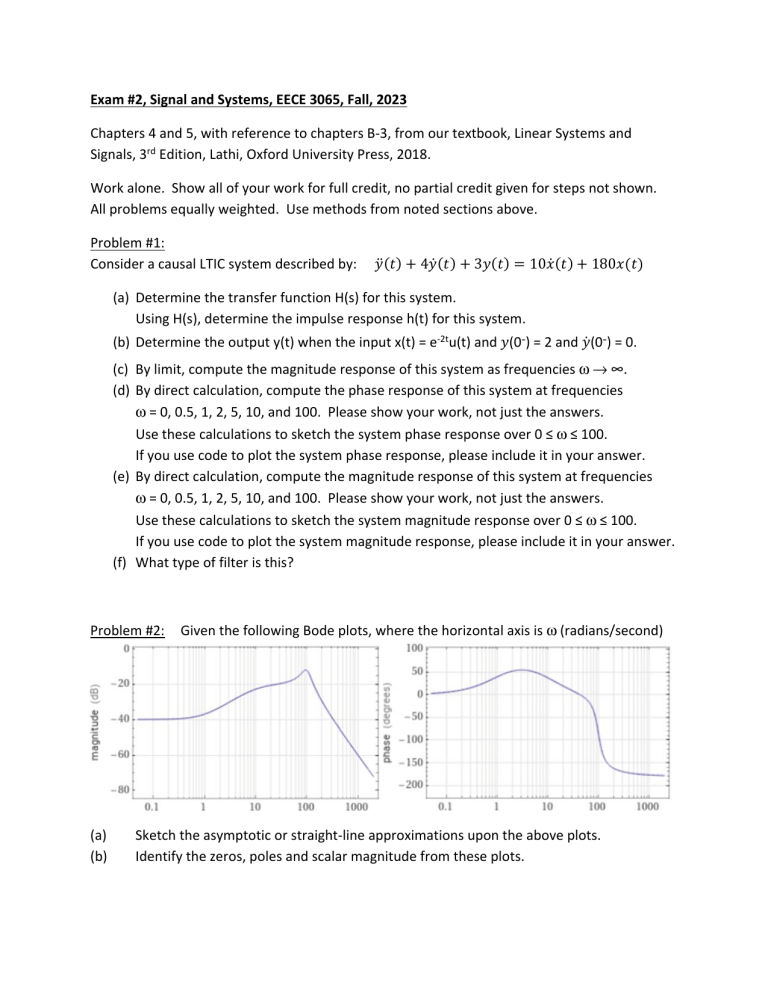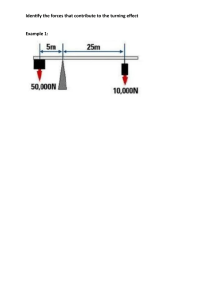
Exam #2, Signal and Systems, EECE 3065, Fall, 2023 Chapters 4 and 5, with reference to chapters B-3, from our textbook, Linear Systems and Signals, 3rd Edition, Lathi, Oxford University Press, 2018. Work alone. Show all of your work for full credit, no partial credit given for steps not shown. All problems equally weighted. Use methods from noted sections above. Problem #1: Consider a causal LTIC system described by: 𝑦 𝑡 4𝑦 𝑡 3𝑦 𝑡 10𝑥 𝑡 180𝑥 𝑡 (a) Determine the transfer function H(s) for this system. Using H(s), determine the impulse response h(t) for this system. (b) Determine the output y(t) when the input x(t) = e-2tu(t) and 𝑦(0-) = 2 and 𝑦(0-) = 0. (c) By limit, compute the magnitude response of this system as frequencies ω → ∞. (d) By direct calculation, compute the phase response of this system at frequencies ω = 0, 0.5, 1, 2, 5, 10, and 100. Please show your work, not just the answers. Use these calculations to sketch the system phase response over 0 ≤ ω ≤ 100. If you use code to plot the system phase response, please include it in your answer. (e) By direct calculation, compute the magnitude response of this system at frequencies ω = 0, 0.5, 1, 2, 5, 10, and 100. Please show your work, not just the answers. Use these calculations to sketch the system magnitude response over 0 ≤ ω ≤ 100. If you use code to plot the system magnitude response, please include it in your answer. (f) What type of filter is this? Problem #2: (a) (b) Given the following Bode plots, where the horizontal axis is ω (radians/second) Sketch the asymptotic or straight-line approximations upon the above plots. Identify the zeros, poles and scalar magnitude from these plots. Problem #2: (continued) (c) Given that the second order pole spikes about +6dB above its asymptotic approximation, what is ζ (zeta or damping) for this case? Given this ζ and your decision for the second order pole location ωn, what then must be the coefficient 2ζωn for the second order term? (d) Given the above, what is the transfer function H(s) = H(jω)? I suggest that you check your work by now finding the Bode plots for your answer for H(s). Problem #3: The figure below displays the pole-zero plot of a third-order real, causal LTID system that has H[z = 1] = 1. Note the two conjugate poles at 𝑧 single zero at 𝑧 𝑗 , the single pole at 𝑧 0.8, and the 1, such that the zero is right on the unit circle. (a) Determine the six constants k, b0, b1, b2, a1, a2 and a3 that specify the transfer function: 𝐻𝑧 𝑘 𝑏𝑧 𝑏 𝑏 𝑧 𝑧 𝑎 𝑧 𝑎 𝑧 𝑎 (b) Using the techniques of Section 5.6, accurately sketch the system magnitude response |H[ejΩ]| over the range (0 ≤ Ω ≤ π). What type of filter is this? (c) Determine the output y[n] of this system if the input is x[n] = sin(πn/4).



